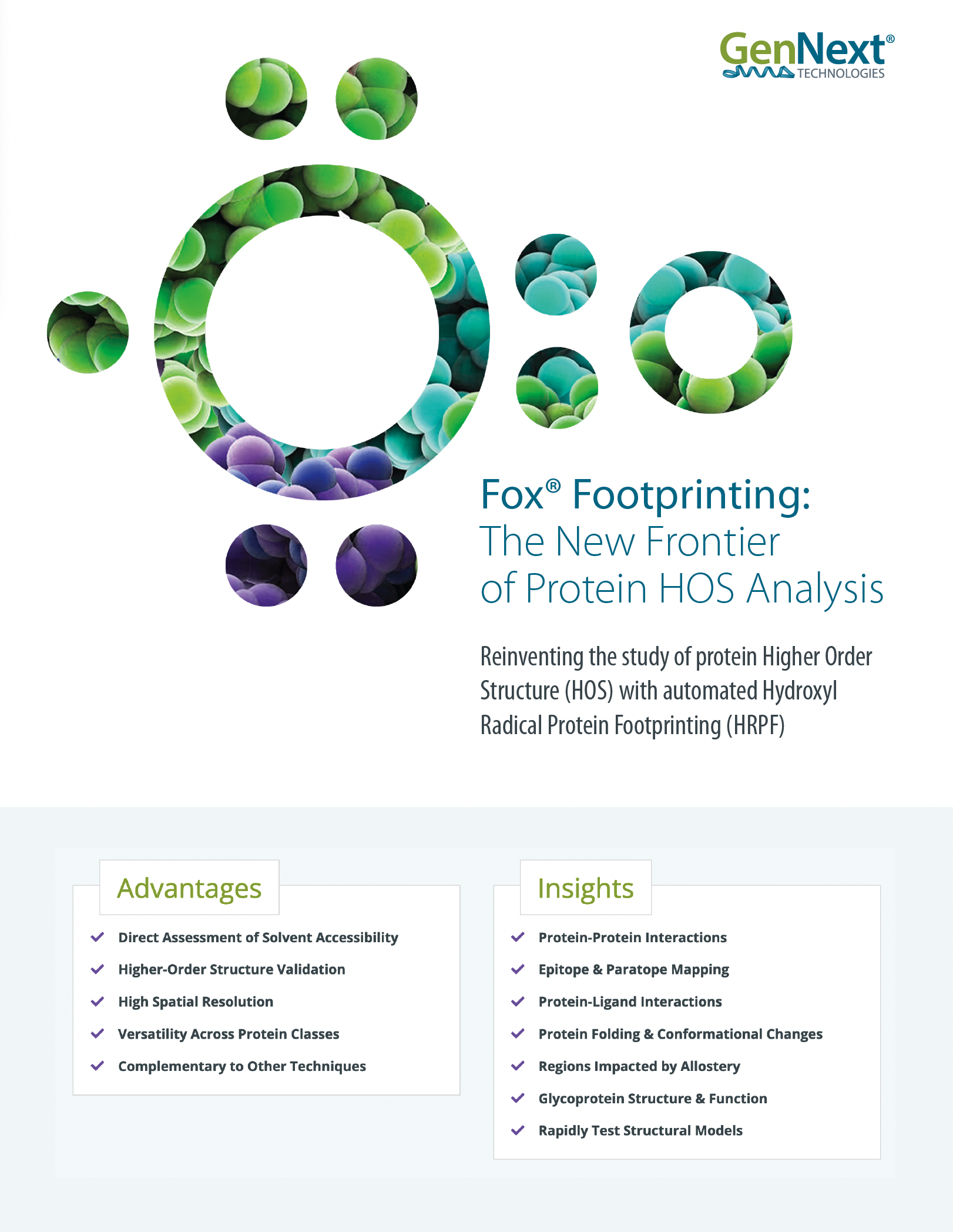
Unique Advantages & Insights of Fox Protein Footprinting
Fox Systems deliver high-value insights into the higher order structure from a diverse range of protein classes and systems. These discoveries have the potential to greatly influence decision-making at every stage of the drug discovery and development journey, all leading to the design and production of safer, more effective, and stable therapeutics.
Discover the cutting-edge advantages and new insights available with Fox Protein Footprinting Systems.
UNIQUE ADVANTAGES
Fox Systems directly measure the solvent accessibility of most amino acid side chains within a protein. By reacting hydroxyl radicals (•OH) with amino acid side chains, the Fox Technology can identify individual residues that are exposed to the solvent and those that are shielded within the protein structure. This information is critical for understanding protein folding, dynamics, and interactions.
Fox Technology can be used to validate the higher order structure of complex biologics, such as mAbs, by confirming the correct folding and assembly of the protein. By comparing the experimental Fox data with the expected solvent accessibility based on the known protein structure, researchers can assess the structural integrity and accuracy of the higher-order structure of the biologic.
Fox Systems deliver high spatial resolution information about protein structure such as pinpointing specific amino acids and regions within a protein that are solvent-accessible or buried. This level of detail allows researchers to map protein surfaces and identify regions involved in protein-protein or protein-ligand interactions accurately.
Fox Systems handle a wide range of protein classes, including ones that are soluble, within the membrane, or form complexes. Not limited by size, type, or structure, Fox Footprinting enables researchers to study diverse protein systems. Able to handle very large and heterogeneous systems, insights generated by Fox HRPF contribute to a better understanding of protein function and communication.
Fox Technology complements other structural biology techniques, such as X-ray crystallography, nuclear magnetic resonance (NMR) spectroscopy, Hydrogen/Deuterium eXchange (HDX), cryo-electron microscopy (cryo-EM), and molecular modeling. Fox Technology provides information about solvent accessibility and dynamics in native solution state conditions that may not be readily available from other methods. By combining Fox protein footprinting with other techniques, researchers can obtain a more comprehensive understanding of protein structure and function.

NOVEL
INSIGHTS
Fox Systems identify protein-protein interaction sites and interfaces. By measuring how protein-protein interactions change the solvent accessibility of residues at the interaction interface, Fox Systems can pinpoint the regions or domains responsible for binding. This information helps researchers understand the structural basis of protein interactions, including those involving mAbs and their target antigens or other interacting proteins.
Fox Technology generates valuable information about the solvent accessibility of residues involved in antibody-antigen interactions, and can rapidly and confidently identify changes that occur upon binding. This approach allows for the identification and mapping of the mAb’s epitopes and paratopes, providing insights into the binding interfaces and the regions responsible for antibody-antigen recognition. This knowledge is crucial for the design and optimization of therapeutic antibodies and diagnostic reagents.
Fox Systems uncover valuable information about protein-ligand interactions. By assessing changes in solvent accessibility upon ligand binding, Fox Technology can identify residues involved in the binding site and reveal the conformational changes induced by the ligand. This information aids in understanding the binding mechanism and guiding drug discovery efforts.
Fox Systems detect conformational changes and dynamics within a protein. By comparing Fox data across different conditions or time points, researchers can identify regions or domains that undergo structural rearrangements, exposing or shielding certain residues. This capability allows for the study of conformational dynamics, such as ligand-induced conformational changes or structural responses to environmental factors.
Fox Technology identifies regions influenced by allostery which are critical for understanding how proteins transmit signals and undergo functional changes. By uncovering the regions impacted by allostery, the Fox-based HRPF method helps elucidate the underlying mechanisms of protein function and assists in drug discovery efforts targeting allosteric sites.
Fox Systems reveal the solvent accessibility of glycoproteins. Glycans shield certain amino acids from oxidation, allowing researchers to understand glycan-protein interactions. Additionally, the approach helps analyze glycoprotein conformational changes and glycoprotein-protein interactions under various conditions, providing a more comprehensive understanding of glycoprotein structure and function.
To rapidly test structural models, Fox data can be compared to the predicted solvent accessibility and flexibility from the structural model of the protein. Areas of the protein that are more susceptible to hydroxyl radical modification correspond to regions that are flexible in the model. Conversely, regions that are protected from modification correspond to buried or rigid regions. Discrepancies between the experimental data and the structural model can indicate potential structural inaccuracies. This information can be used to refine or validate the structural model.

